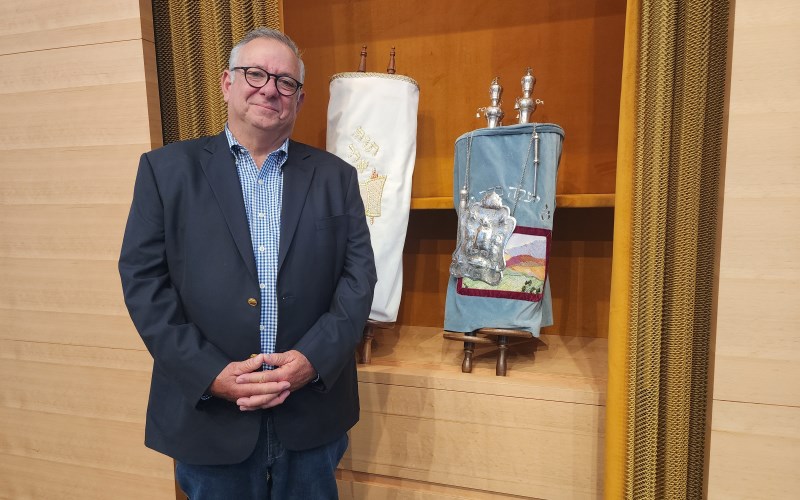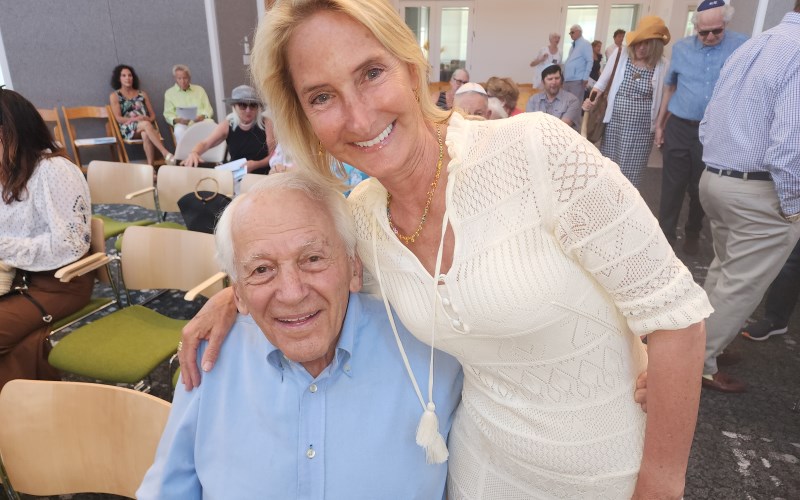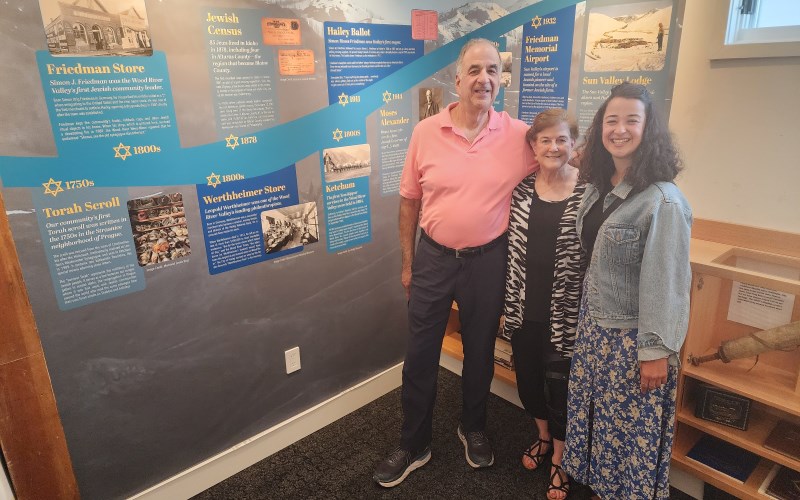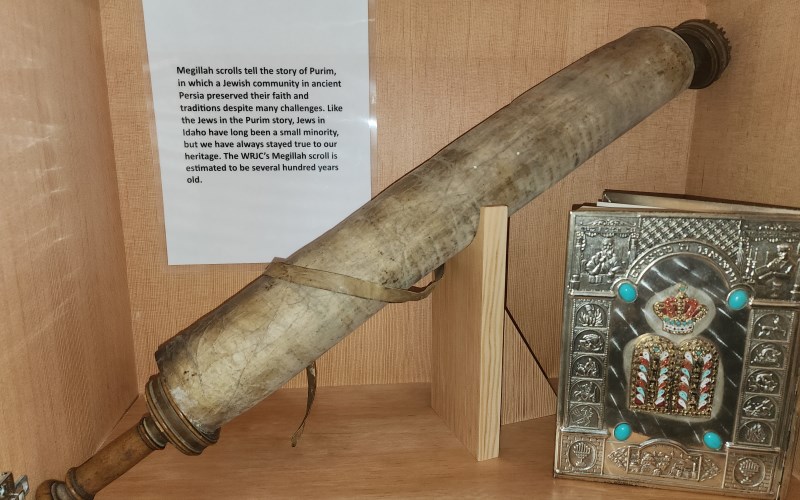|
STORY AND PHOTOS BY KAREN BOSSICK The Bannock Indian War of 1879 was still a year in the future when the first Jewish settlers began arriving in the Wood River Valley to mine for silver and gold, herd sheep and cattle and open some of the valley’s first mercantile stores. They and those who followed helped build a community out of the wild, wild west, serving as civic leaders, donating the land for what would become the second busiest airport in Idaho and founding philanthropic organizations to address the needs of the valley. And finally, on Sunday—145 years after the first Jewish people arrived--the Wood River Jewish Community dedicated its new synagogue—only the third in Idaho.
|
|

Jeff Rose, the president of the Wood River Jewish Community, noted that mining and sheep herding brought Jews to the Wood River Valley in the 1800s; many came later because of Sun Valley’s skiing, biking and other outdoor pursuits.
|
|
|
“Welcome to the home of the Wood River Jewish Community,” WRJC President Jeff Rose told 175-some celebrants packed into the new Wood River Jewish Community's Lewis Family Center in Elkhorn. “A house is a building and a home is a place where we dwell. This is our home.” Twenty-seven Jews held their first Yom Kippur services in the Wood River Valley in 1884 in Hailey’s Masonic Hall, breaking their fast with fresh oysters, speckled Eastern trout, stuffed spring chicken, stuffed teal duck, fresh oyster salad and English plum pudding. They rounded out the evening singing operatic songs. Theirs has been a nomadic life since, as they’ve held Shabbat services, High Holy Days, Passovers and Hannukkah services in homes, Our Lady of the Snows Catholic Church, the American Legion Hall and the Sawtooth Botanical Garden. Until the late 20th century Wood River Valley Jews traveled to Boise or Salt Lake City for holidays. Then Naomi Fine Sloan and Helen Goldberg began organizing “Temple Beth Baldy” Passover celebrations in Sun Valley’s Lodge Dining Room, Trail Creek Cabin and The Tram.
|
|

The Lewis family, including Ken and Laura Rose-Lewis, were recognized for being the first to jump in and throw their support behind the building of the synagogue.
|
|
|
The group began making their home at the Presbyterian Church of the Big Wood, more recently operating out of St. Thomas Episcopal Church, before taking a step of faith to build their own home. They planted their stake in the ground at Elkhorn just weeks before the COVID-19 pandemic outbreak started, leading to labor and supply chain shortages and delaying the synagogue’s opening by a year. Even Sunday a few things were left to be done, including the installation of panels that will cover the Torah area when community groups use the facility for weddings and other events. “When one makes plans, God laughs, and we’re finishing the building as we dedicate it,” noted WRJC President Jeff Rose, who co-chaired the building project with Marty Lyon. Sun Valley Mayor Peter Hendricks noted that the building has seen many uses since it was built, including that of a neighborhood market.
|
|

Phil, Cathy and Hallie Goldstein said they’re proud of son Ari’s contributions to a display outlining milestones in local Jewish history. “I think it’s important for people to see what came before,” said Cathy.
|
|
|
“None is more monumental than what you’re doing today,” he said. “Welcome home.” The remodel utilized the trusses of the building that had been vacated but it gave the new incarnation a bright, contemporary feel. Leaves incorporated into glass near the Torah symbolize the Tree of Life, which is associated with wisdom, peace, happiness and a source of life. An eternal light shines amidst the utilitarian rings of ceiling lights, signifying that God is always present to guide and sustain. An ark houses two Torahs containing the first five books of the Hebrew Bible. One is a survivor Torah, which was written in the 1750s in Prague, hidden during the Holocaust, restored at London’s Westminster synagogue and brought to Ketchum in 1989.
|
|

The Scroll of Esther is one of the artifacts that can be seen in the “Generation to Generation” room.
|
|
|
Ketchum resident Carlyn Ring recalled the emotional experience of opening the Torah while Sue Mendelssohn played the violin while the WRJC was based at the Church of the Big Wood. “Having our own space is bittersweet in a way,” she noted. “While it’s nice to have a home to call our own, I thought it was so magnificent that a Christian community would tell us: Welcome. Let our home be your home.” The Rev. Kathleen Bean of St. Thomas Episcopal Church seemed to echo her sentiments as she and the Rev. Jonah Kendall offered the community a blessing: “You lived in our hearts. We felt honored by your presence.” More than 200 families and individuals contributed to the new synagogue building, with Ken and Joyce Lewis acknowledged as the first to support the vision. Their contribution is recognized in the naming of the Lewis Family Center.
The contributions of the Naomi Fine Sloan’s family went towards the Naomi Fine Sloan Sanctuary. Marshall and Judith Meyer’s family covered The Ark; Judith Teller Kaye and David Kaye, the Teller Family Oneg Space; Ron and Susan Green, Ner Tamid, and Larry and Glenda Mamkarsh, the rabbi’s office. The Annenberg Foundation supported the Annenberg Classroom. “This is what happens when dreamers and doers come together,” the Rabbi Roberto Graetz told those assembled. “ ‘You will build a sanctuary,’ God says, ‘And I will live among you.’ ” Phil and Cathy Goldstein and Marty and Mila Lyon created the “Generation to Generation” history room, charting some of the milestones in the history of the Jewish people in Idaho and the Wood River Valley. The timeline, which includes research uncovered by Ari Goldstein, tells that 85 Jews lived in Idaho in 1878, including four in what would become Blaine County.
It tells the story of Simon J. Friedman, who became one of the first merchants in the Wood River Valley, and his second cousin Simon M. Friedman, who was elected Hailey’s first mayor. Friedman became the only Jewish person in America to have an airport named for him after his children deeded a 76-acre parcel of his sheep farm to the City of Hailey for use as an airport. Friedman’s daughter Lucile said the business of being mayor in 1909 was anything but pleasurable—“Someone was always getting Dad out in the middle of the night to get a cow out of their yard or something.” The timeline describes how Moses Alexander was the first Jewish governor in the United States and that Boise’s Ahavath Beth Israel is the longest continually running synagogue west of the Mississippi River. It also tells of Jewish cowboy Aaron Morris, who was shot by bandits while riding his horse from Ketchum to Hailey at midnight in the days when Jewish men served as ranchers and cowboys. “I’m swelling with kvell, which is something Jewish mothers do when their kids do something great,” said Hailey resident Coni Foster as she surveyed the celebration. “This is a joyous occasion.”
“Today we plant our tent here for many, many generations to come,” said Marty Lyon. “But we’re part of a wider valley of friends, and we need to integrate the greater community into our home.”
|